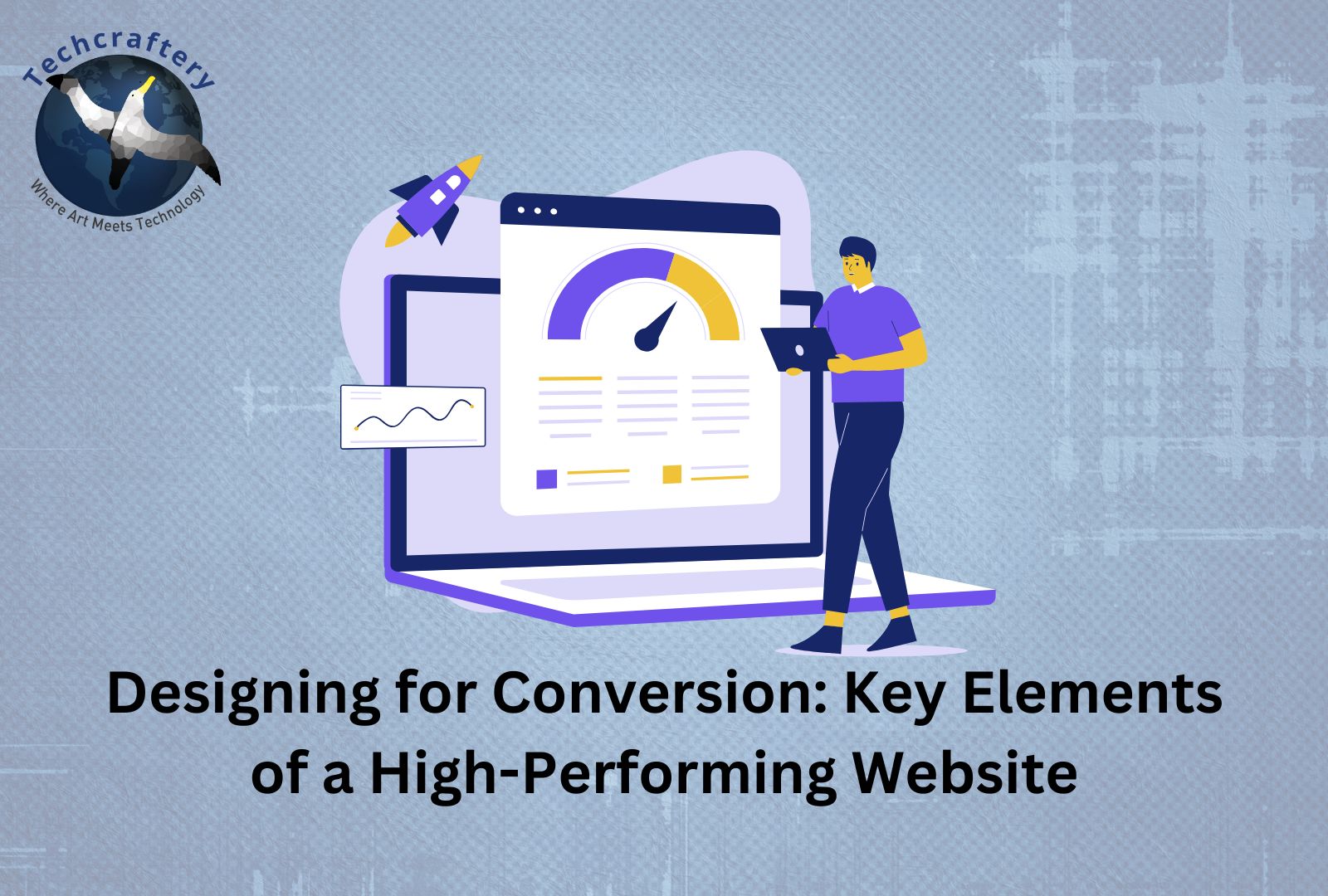In today’s digital age, having a website is no longer optional; it’s a necessity. But having just any website won’t suffice. It needs to be a high-performing website, designed with conversion in mind, to ensure it meets its ultimate purpose—turning visitors into customers. Whether you’re running an e-commerce store, a blog, or a service-based business, website conversion rates are key metrics that can make or break your online success. So, what are the key elements of a high-performing website designed for conversion? Let’s dive deep into the strategies and principles that ensure your website converts visitors into loyal customers.
1. User-Centric Design
A high-performing website prioritizes the user experience. It’s crucial to design the website by putting yourself in the shoes of the user. What do they need? What are they looking for? The answers to these questions should guide every design decision.
Simplicity and Clarity
One of the most important aspects of user-centric design is simplicity. Your website shouldn’t overwhelm visitors with too much information or too many visual elements. Clear, concise messaging combined with a clean, simple layout helps users understand your offerings quickly.
Intuitive Navigation
If users can’t find what they’re looking for in a matter of seconds, they’re likely to leave. A simple, intuitive navigation menu is essential. Whether it’s a hamburger menu on mobile or a horizontal menu on desktop, the navigation should lead users to important pages effortlessly.
Consistent Branding
Brand consistency helps build trust with your audience. Ensure that your colors, fonts, and imagery reflect your brand’s identity. The tone of voice, style of visuals, and layout should feel cohesive across all pages of your website.
2. Mobile-First Design
Mobile traffic now accounts for a significant portion of global internet usage, making it essential that your website is optimized for mobile devices. If your website doesn’t function well on smartphones and tablets, you’re potentially losing out on a large percentage of your audience.
Responsive Design
A responsive website automatically adjusts its layout based on the device it’s being viewed on. Whether a visitor is using a desktop, tablet, or smartphone, they should have a seamless experience. Everything from images to text blocks should resize appropriately without disrupting the user experience.
Speed Optimization for Mobile
Mobile users expect faster load times, and studies show that if a website takes longer than three seconds to load, a significant number of visitors will abandon it. Use tools to optimize your website for speed by compressing images, enabling browser caching, and reducing unnecessary code.
3. Clear Calls to Action (CTAs)
Calls to action are one of the most crucial elements of a high-performing website. They tell users what to do next—whether it’s signing up for a newsletter, making a purchase, or filling out a contact form. A well-designed CTA can have a major impact on your conversion rate.
Design of CTAs
Your CTA buttons should stand out from the rest of your page. This is typically achieved through color contrast. The button should be large enough to click easily, and the text should be concise, action-oriented, and relevant (e.g., “Buy Now,” “Get Started,” or “Subscribe”).
Placement of CTAs
Place CTAs strategically throughout your website. The best practice is to include a CTA above the fold—meaning users don’t need to scroll down to see it. However, ensure you don’t overwhelm visitors by placing too many CTAs on one page. A balance is key.
4. Effective Use of Visuals
Humans are visual creatures, and incorporating images, videos, and graphics into your website can enhance its appeal and effectiveness. However, these visuals need to be purposeful and contribute to the user experience rather than clutter the design.
High-Quality Images
The images you use should be of high quality and aligned with your brand. Avoid using stock photos that look generic or fake. If possible, use original photos that show your products, team, or services in action. This builds trust and makes your website feel more authentic.
Videos for Engagement
Adding a video to your landing page can increase conversion rates significantly. Whether it’s a product demo, customer testimonials, or a brand story, videos can quickly convey complex information and engage users.
Infographics for Information
Infographics are a great way to present data or information in an engaging, easy-to-understand format. They can help break down complex topics, making them more digestible for your audience.
5. SEO Optimization
A website isn’t truly high-performing unless it’s visible. Search Engine Optimization (SEO) ensures that your website ranks higher on search engines like Google, making it easier for potential customers to find you.
Keyword Research
Identify the terms and phrases your target audience is searching for, and use these keywords strategically in your content. Tools like Google Keyword Planner can help you find relevant keywords with high search volumes and low competition.
On-Page SEO Elements
Ensure that your website has the appropriate on-page SEO elements, such as meta titles, meta descriptions, alt tags for images, and header tags (H1, H2, etc.). These elements help search engines understand what your page is about and improve its chances of ranking.
Fast Loading Speed
Search engines like Google also factor in loading speed when determining rankings. As mentioned earlier, optimizing your website for speed is crucial not only for user experience but also for SEO.
6. Trust Signals and Social Proof
Trust is a major factor in converting visitors into customers. Including trust signals and social proof on your website helps build credibility and assures potential customers that they’re making a good decision by engaging with your brand.
Testimonials and Reviews
One of the most effective forms of social proof is customer testimonials and reviews. Displaying positive feedback from previous customers reassures potential buyers and boosts their confidence in your product or service.
Security Badges
If your website involves any form of payment or requires users to share personal information, include security badges to show that their data is protected. This could be in the form of SSL certificates, payment gateway logos, or a trust seal from a recognized authority.
Case Studies
If applicable, showcase case studies of past clients or customers who have achieved success using your product or service. This helps potential customers visualize the benefits of working with you and provides evidence of your expertise.
7. Content That Engages
The content on your website plays a pivotal role in driving conversions. Well-written, engaging content not only informs visitors but also persuades them to take action.
Clear, Concise Messaging
Avoid using jargon or overly complex language. Your messaging should be clear, concise, and to the point. Focus on communicating the benefits of your product or service, not just the features.
Engaging Headlines
Headlines are the first thing visitors read, so they should be attention-grabbing and relevant. A compelling headline can make the difference between a visitor staying on your site or leaving immediately.
Blogs and Educational Content
Creating valuable, educational content in the form of blog posts, how-to guides, or tutorials can help position your website as an authority in your field. This not only builds trust but also improves your SEO ranking, driving more organic traffic to your site.
8. A/B Testing and Analytics
Designing a high-performing website is not a one-time task. It requires ongoing testing, analysis, and optimization to ensure it continues to meet the needs of your audience.
A/B Testing for Optimization
A/B testing involves creating two different versions of a webpage and testing them against each other to see which one performs better. You can test various elements, such as headlines, CTAs, color schemes, and layouts, to find out which version converts better.
Analyzing User Behavior
Use tools like Google Analytics or heatmaps to analyze user behavior on your website. This will give you insights into how visitors interact with your site, which pages they spend the most time on, and where they drop off. This information can help you identify areas for improvement.
9. Fast Load Times
The speed at which your website loads can have a significant impact on conversion rates. A slow-loading website not only frustrates users but also negatively affects your search engine rankings.
Compress Images and Files
One of the main reasons for slow load times is large images and files. Compressing these files without compromising their quality can significantly speed up your website.
Minify Code
Minifying your website’s code by removing unnecessary spaces, line breaks, and comments can improve load times. This makes the code cleaner and faster for browsers to interpret.
Use a Content Delivery Network (CDN)
A CDN helps reduce load times by distributing your website’s static content across multiple servers worldwide. This ensures that users can load your website quickly, no matter where they are.
10. Lead Generation Forms
A high-converting website should make it easy for visitors to provide their information, such as email addresses, for follow-up and lead generation purposes.
Simple Forms
Keep your lead generation forms short and simple. Only ask for essential information, such as name and email address. The more fields you add, the less likely visitors are to fill them out.
Incentives for Submission
Offering an incentive, such as a free e-book, discount code, or access to exclusive content, can encourage visitors to fill out your form. Make sure the incentive is valuable enough to prompt action.





